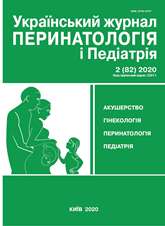Non-compact myocardium of the left ventricle in newborn: literature data and clinical case
DOI:
https://doi.org/10.15574/PP.2020.82.114Keywords:
non-compact myocardium, heart failure, fetus, congenital heart defects, prenatal echocardiographyAbstract
Uncompact left ventricular myocardium is a rare and poorly studied form of cardiomyopathy, which is characterized by a violation of endomyocardial morphogenesis, left ventricular myocardial hypertrophy with its pathological trabecularity and the formation of wide intertrabular spaces. With this pathology, the left ventricular myocardium consists of two layers — normal and non-compact.
This article contains a clinical case of a non-compact myocardium of the left ventricle in newborn. The cause of non-compact left ventricular myocardium is imperfect embryogenesis, because of which the normal development of the myocardium is disturbed. Heart failure is the most common symptom complex in patients with non-compact left ventricular myocardium. An uncompact myocardium is a disorganized layer of muscle fibers, in which normal architectonics is disturbed, which leads to a significant reduction in contractility. Thus, the higher the percentage of non-compact myocardium of the total mass of the heart muscle, the more marked the signs of chronic heart failure. In addition, there is chronic myocardial ischemia, which occurs because of microcirculation disorders. Mortality during the first 6 years is up to 50%. The prognosis also worsens the presence of ventricular arrhythmias. Timely prenatal suspicion of myocardial disease, clarification of the diagnosis immediately after birth and the prescribing of therapy significantly affect the prevention of heart failure.
References
Asw1. Ershova IB, Osipova TF, Nesterova TV, Chernova EV, Gavryish LI, Kalapala B, Matsyuh NV, Karnilovich AS. (2014). Diagnostika nekompaktnogo miokarda levogo zheludochka u detey. Zdorove rebenka. 1: 150–155.
Fazlinezhad A et al. (2016). Echocardiographic Characteristics of Isolated Left Ventricular Noncompaction. ARYA Atherosclerosis. 12 (5): 243–247.
Goluhova EZ, Shomahov RA. (2013). Nekompaktnyiy miokard levogo zheludochka. Kreativnaya kardiologiya. 1: 35–45.
Makarenko VN, Aleksanrova SA, Dariy OYu. (2011). Otsenka strukturno-funktsionalnogo sostoyaniya miokarda s pomoschyu magnitno-rezonansnoy tomografii u patsientov s sindromom «nekompakntyiy miokard». Diagnosticheskaya i interventsionnaya radIologIya. 5 (2): 256.
Mitrofanova IS, Boriseyko GR, Maylanova LH, Maslova NV, Byikova SS. (2016). Nekompaktnyiy miokard (klinicheskiy sluchay). Mezhdunarodnyiy zhurnal prikladnyih i fundamentalnih issledovaniy. 3–4: 581–583.
Schwartzenberg S, Sherez J, Wexler D et al. (2009). I solated ventricular non-compaction: an under-diagnosed cause of congestive heart failure. IMAJ. 11: 426–429.
Stollberger C, Finsterer J. (2004) Left ventricular abnormal hypertrabeculation/ noncompaction. J. Am. Soc. Echocardiogr. 17: 91–100. https://doi.org/10.1016/S0894-7317(03)00514-5
Umarova MK, Basargina EN, Smirnov IE. (2016). Nekompaktnyiy miokard levogo zheludochka u detey: klinicheskie proyavleniya i prognoz. Rossiyskiy pediatricheskiy zhurnal. 3: 174–182.
Downloads
Published
Issue
Section
License
The policy of the Journal “Ukrainian Journal of Perinatology and Pediatrics” is compatible with the vast majority of funders' of open access and self-archiving policies. The journal provides immediate open access route being convinced that everyone – not only scientists - can benefit from research results, and publishes articles exclusively under open access distribution, with a Creative Commons Attribution-Noncommercial 4.0 international license(СС BY-NC).
Authors transfer the copyright to the Journal “MODERN PEDIATRICS. UKRAINE” when the manuscript is accepted for publication. Authors declare that this manuscript has not been published nor is under simultaneous consideration for publication elsewhere. After publication, the articles become freely available on-line to the public.
Readers have the right to use, distribute, and reproduce articles in any medium, provided the articles and the journal are properly cited.
The use of published materials for commercial purposes is strongly prohibited.

